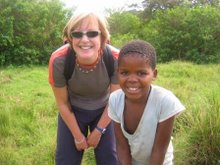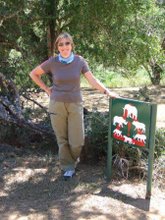We headed off to Cairo´s spectacular new bus station Turgoman early in the morning and got tickets on the 9.30 bus to Suez. We thought. Turned out that our tickets were for the bus that left at 8.30, and we had been the victim of someone with English not quite as good as they thought. By the time the confusion had been sorted out and we had reluctantly paid an extra 2 Egyptian pounds each to have our tickets revalidated for a later journey, we´d missed the 9.30 and ended up on the 10am bus. Just as well we´d benefited from the end of daylight saving in Egypt and had gained an extra hour. Suez isn´t that far, and we were in the port area at lunchtime, looking for somewhere to eat with a view of the canal. The Red Sea Hotel fitted the bill, but then we learned that the canal closed between 2 and 4pm so the ships could change direction - the canal is one-way. We spent a couple of hours eating very indifferent and expensive food, and admiring an empty waterway. Still, we can say we´ve seen it, and there were some ships on the horizon.
Back to the bus depot, with the idea of buying tickets for the 5.00pm service to Alexandria. Again, no. All sold out. It was getting close to Ramadan and Egyptians, and indeed people all over the Arab world, were starting to make their way home for the holidays. If you had ever thought it was difficult to buy All Black test tickets, you haven´t been in a bus queue in Egypt at Ramadan trying to buy a ticket to Cairo. There was a service at 5.30 and the tickets went on sale about 4.45. I stood in the women´s queue, unashamedly holding my ground, and watched in amazement as a fight broke out in the men´s queue. The bus guy left the safety of his office and started pulling people off each other and managed to instill some order into proceedings. I and all the other women got tickets, but I could´t be sure about the men - there were a lot of them. We got back to Turgoman about 7.30, and bought tickets for the 8.30pm service to Alexandria, this time being pedantically careful to check departure times and gate numbers. Eventually the Tourist Police got so tired of us that they personally escorted us to the bus when it arrived. It was late when we got into the port town, but we´d all got some sleep on the way, and were keen to head out and check out the Corniche on the shores of the Mediterranean. We booked into the Union Hotel on the waterfront and went walking. It was warm and pleasant, cafes were open and people were drinking coffee and enjoying the night air. We bought ice creams and wandered back to the hotel, pleased to finally be here. Alexandria was the most cosmopolitan city in Egypt at the time of the revolution in 1952, and as a consequence suffered quite badly. But it has retained its European air, and is now famous for the diving, the new library, and the scores of atmospheric cafes frequented by tourists and locals alike.
The next morning we checked out the diving - we were keen to use our new skills but the options that Dive Alexandria presented were expensive and not compelling enough to have us fork out more than $100US each. There was nothing for it but to go for coffee - the cafe next door was a gem. Shady, with lots of greenery, good coffee and service and the most sparkling loos I´d seen in a long while. We dragged ourselves away eventually and strolled along the waterfront, past the rather manky looking local beach and lots of fishing boats to Fort Quaisbey. The Fort had a great spot on the edge of the promontory, but these days houses a sort of diaorama aquarium - fine if plaster renditions of underwater scenes are your thing. After our walk, it was obviously time to eat again, and we were looking forward to a good seafood lunch. The Fish Market overlooked the waterfront and we selected crabs and sea bass from the ice display which we ate with many bowls of salads and dips, and even a chilled bottle of rose. It was a long walk back to Delices, our cafe of choice, for afternoon coffee and cake, and we decided that a horse and carriage ride to the eagerly anticipated Biblioteca Alexandrina was in order. I had been looking forward to seeing the Library and it didn´t disappoint. The building is fantastic and the work they are doing to scan and make freely available their ancient manuscripts, as well as the digital archive of the internet and a cutting edge print on demand system for the library´s publications were equally impressive. We decided we´d had enough of buses for a while and got tickets for the train back to Cairo, arriving in time for us to head to the Windsor for a well earned cold beer and a late supper.
It had been a bit of a whirlwind couple of days, and it was almost hard to believe that our six months was nearly over, but there was still something important to see - the pyramids and the Sphinx. We had, for some reason, avoided making the trip to Giza until now, but it could be put off no longer. After some minor fuss connected with retrieving our plane tickets for Madrid from one of the city´s DHL depots, we headed out to the site in a taxi. It was mid-morning, hot and dusty and the great pyramid poked out from behind a sand hill as we trudged up the hill, past the entrance gate, the dozen or so tour buses and the many horse and camel drivers, to get close to it. It was big - huge granite and limestone cubes (though there is some discussion that some of the upper blocks are actually ¨concrete¨) piled into that well known shape. The three remaining pyramids at Giza are fabulous and photogenic, but my favourite was the Sphinx. Mysterious, curious and other-worldly, it sat guard secure on its giant haunches and with its large paws extending out towards...Pizza Hut! Not quite the same as the reconstruction in my guidebook which had it overlooking the Nile, but that´s contemporary Cairo for you! After some debate, we hired horses and went for a short ride into the dunes so we could look back at the pyramids, and incidentally the city of Cairo. It was fun to do, and luckily my horse was terribly tame and mostly plodded along a well worn track and, on balance, I believe it was a better choice than a camel or a donkey.
Our last night in Cairo, our last night in Africa, was a bit odd because of Ramadan. The streets were quiet, only cafes with locals watching football seemed to be open, but we did find a Chinese restaurant only it wasn´t serving alcohol because of the season. No matter, we happily ate our spring rolls and chicken and cashew nuts and headed back to the venerable Windsor Hotel for a farewell gin and tonic. The ancient bartender greeted us warmly and we toasted the end of the adventure...for now.





